Abstract
The affinity and potency of McN-A-343 (4-(m-chlorophenyl-carbamoyloxy) -2-butynyltrimethylammonium chloride) has been assessed at a range of M1 and M2 muscarinic receptors. McN-A-343 was shown to act as a full agonist at M2 receptors present in the guinea-pig isolated taenia caeci (-log EC50 = 5.14). McN-A-343 exhibited no agonist action in the guinea-pig ileum, atria, bladder or trachea. McN-A-343 was not selective in terms of affinity since its dissociation constants at M1 and M2 binding sites in the rat cerebral cortex and myocardium respectively, were very similar (cortical pPKi = 5.05; myocardial pKi = 5.22). The selectivity previously reported for the compound may be due to differences in intrinsic efficacy and/or tissue receptor reserve. Based on differential antagonist affinities, the muscarinic receptor profile of the taenia caeci, trachea and bladder was similar to that observed in the ileum, but dissimiliar to that observed in the atria.
Full text
PDF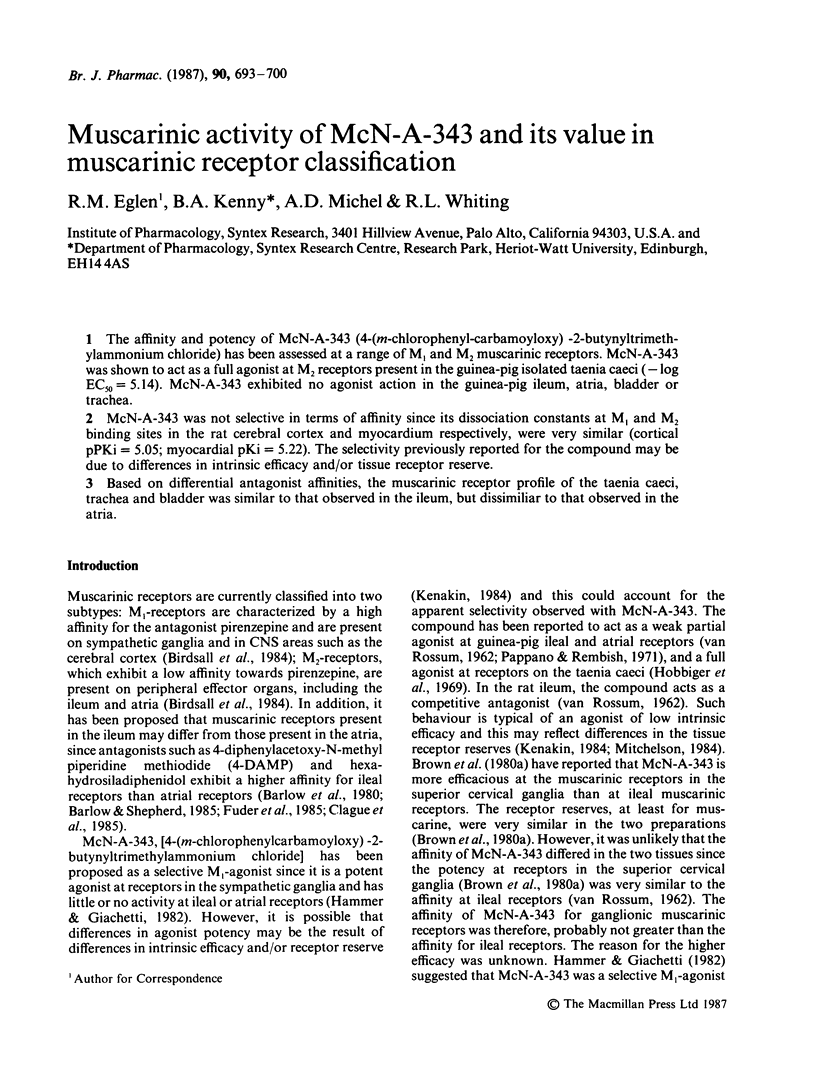
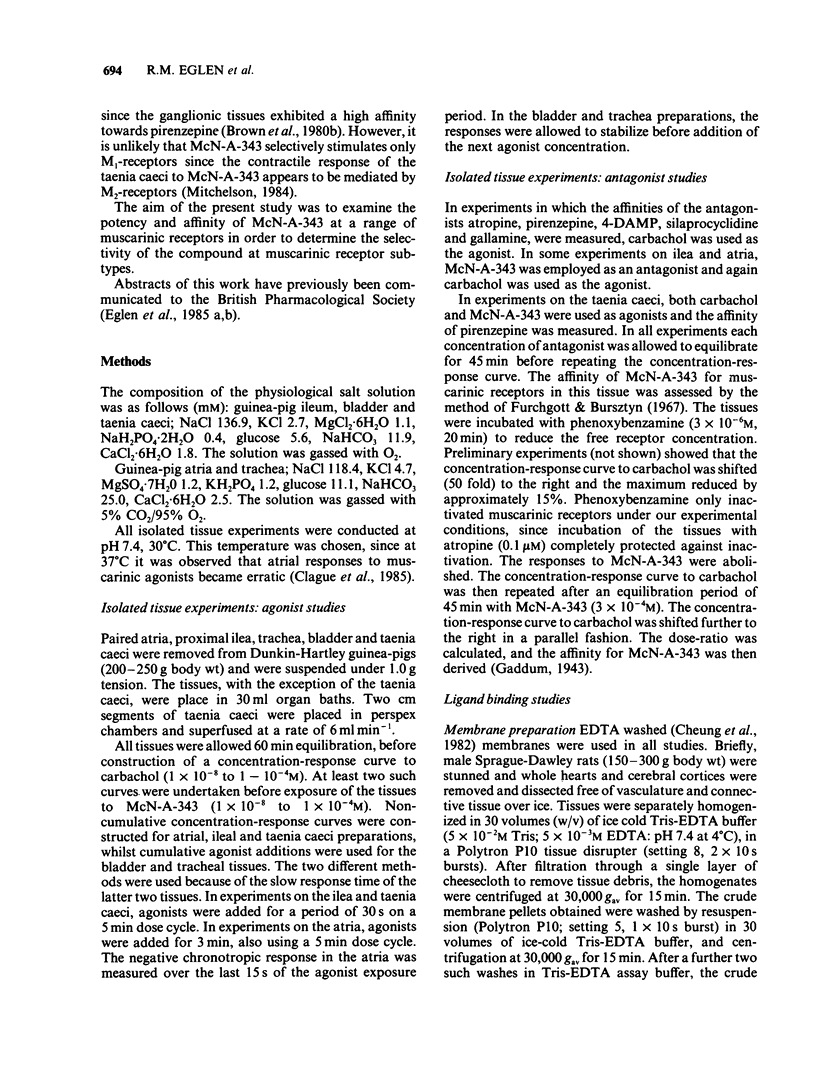
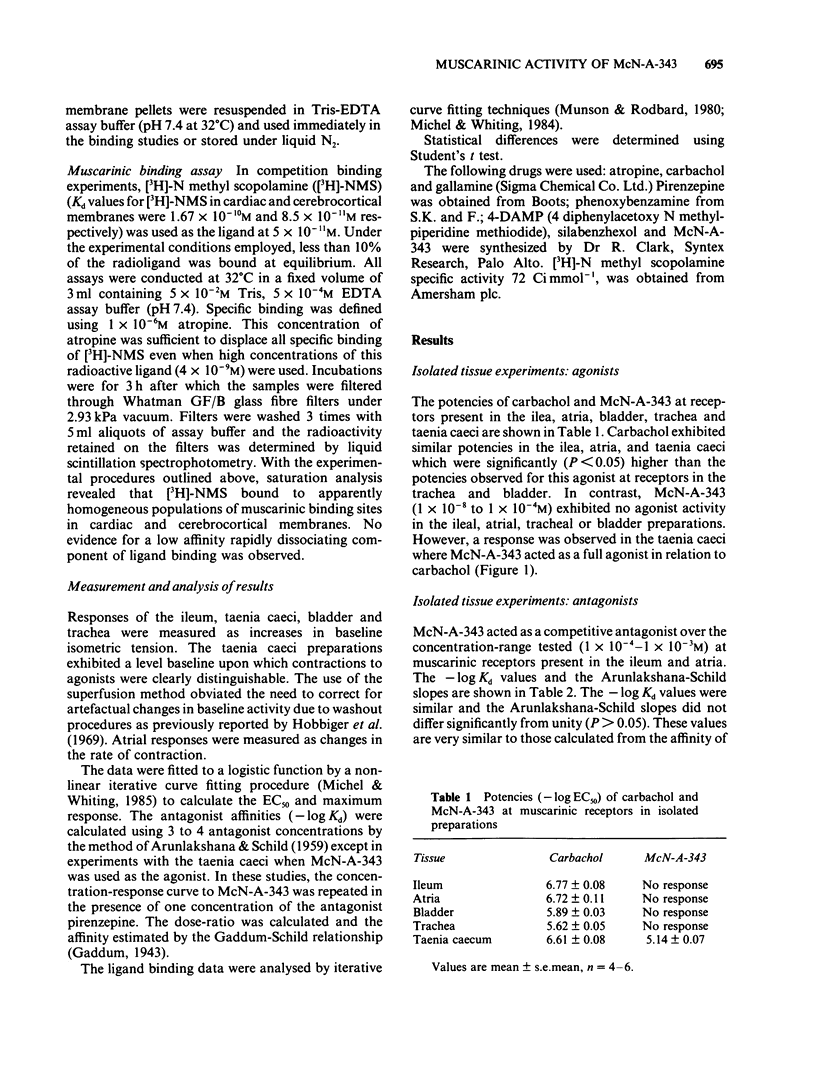


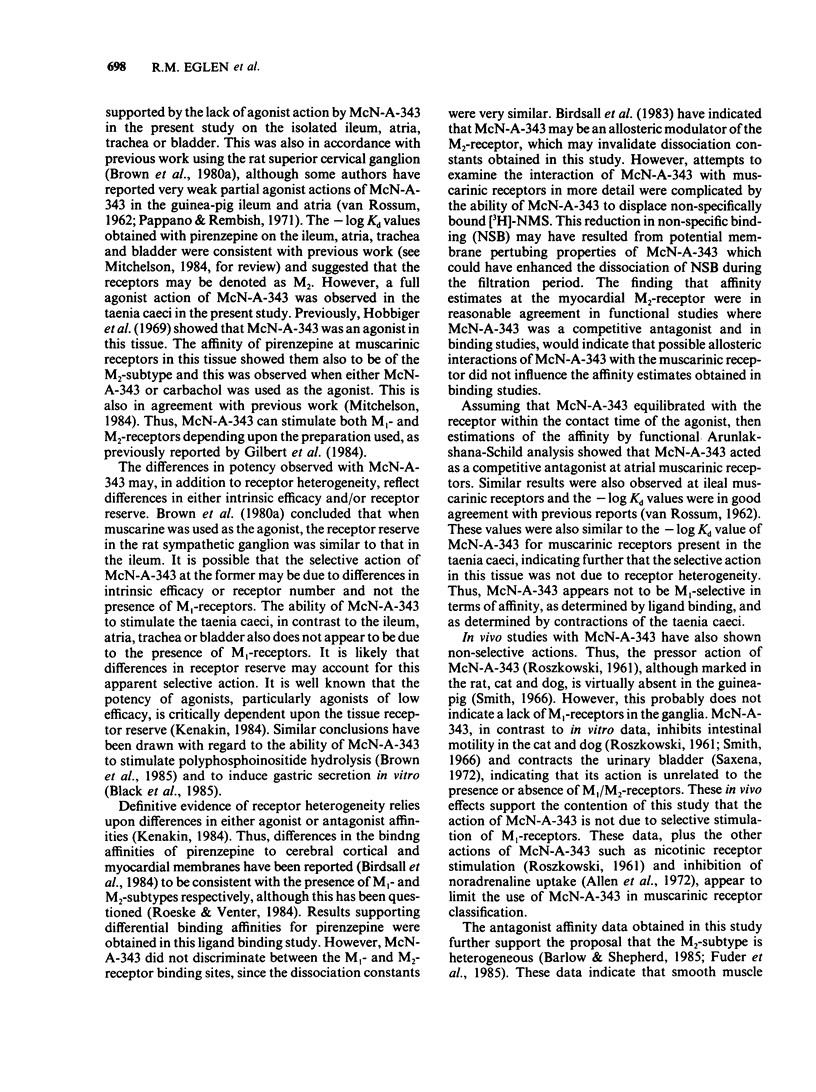
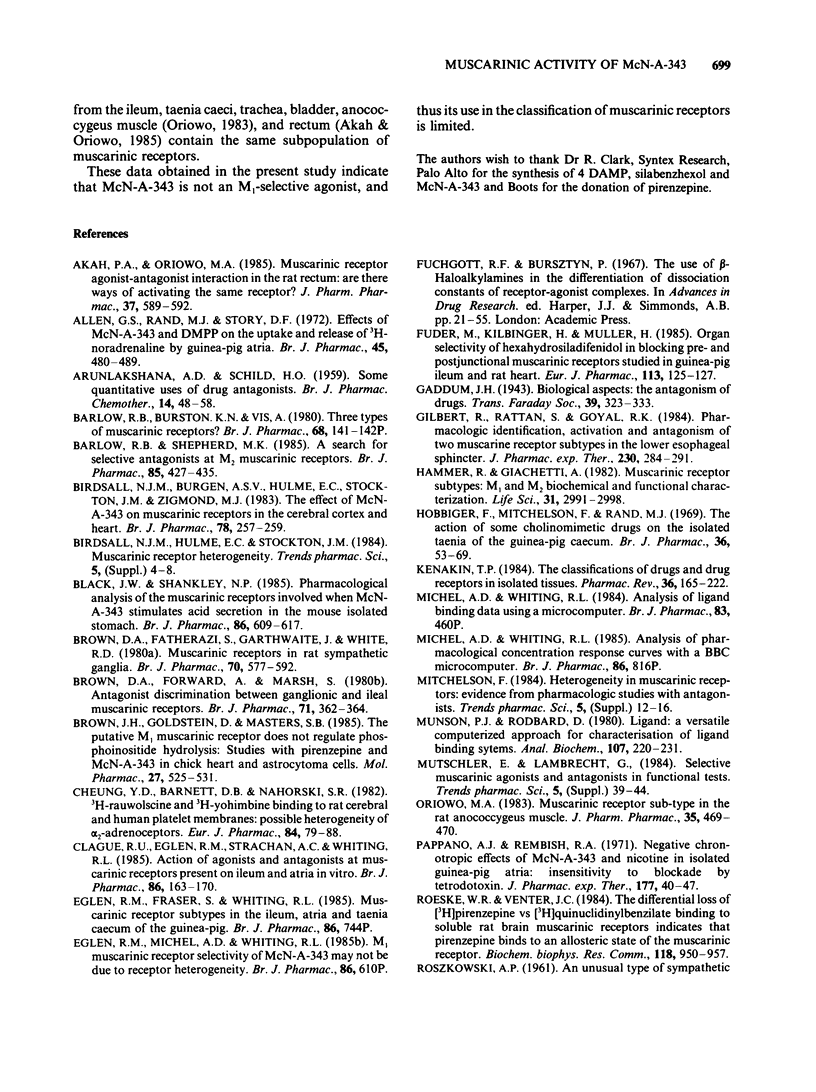
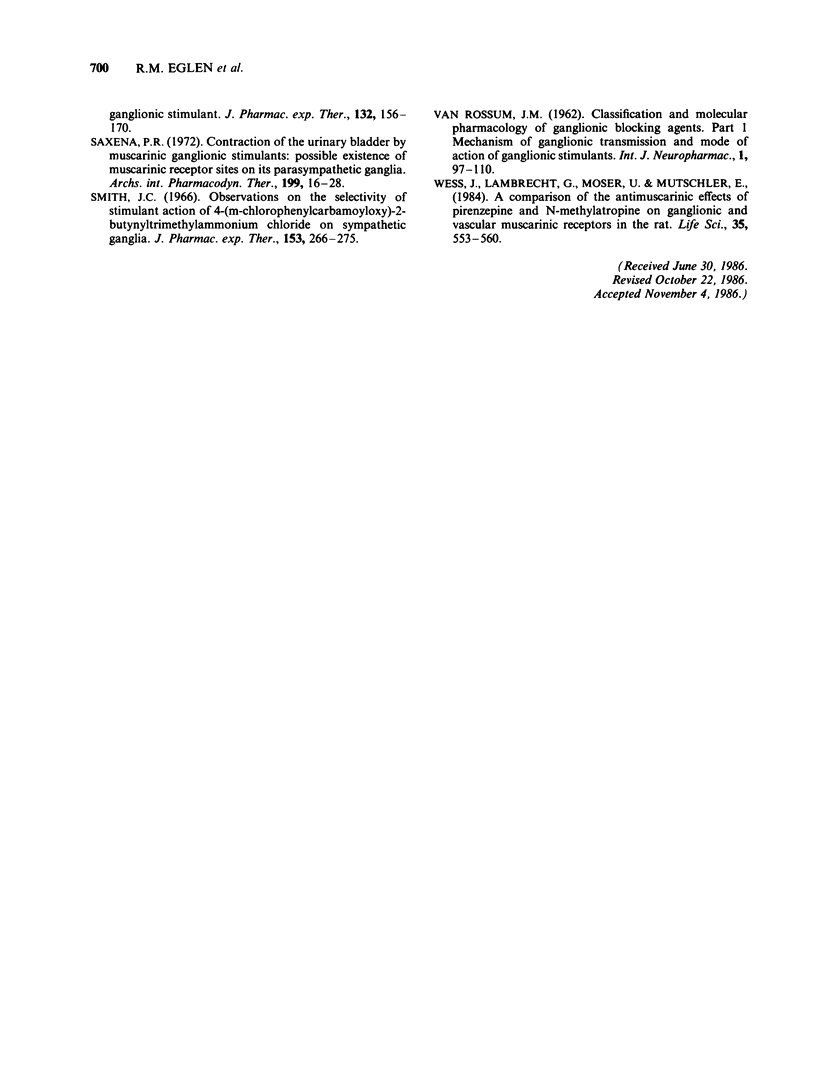
Selected References
These references are in PubMed. This may not be the complete list of references from this article.
- ARUNLAKSHANA O., SCHILD H. O. Some quantitative uses of drug antagonists. Br J Pharmacol Chemother. 1959 Mar;14(1):48–58. doi: 10.1111/j.1476-5381.1959.tb00928.x. [DOI] [PMC free article] [PubMed] [Google Scholar]
- Akah P. A., Oriowo M. A. Muscarinic receptor agonist-antagonist interaction in the rat rectum: are there ways of activating the same receptors? J Pharm Pharmacol. 1985 Aug;37(8):589–592. doi: 10.1111/j.2042-7158.1985.tb03078.x. [DOI] [PubMed] [Google Scholar]
- Allen G. S., Rand M. J., Story D. F. Effects of McN-A-343 and DMPP on the uptake and release of 3 H-noradrenaline by guinea-pig atria. Br J Pharmacol. 1972 Jul;45(3):480–489. doi: 10.1111/j.1476-5381.1972.tb08105.x. [DOI] [PMC free article] [PubMed] [Google Scholar]
- Barlow R. B., Burston K. N., Vis A. Three types of muscarinic receptors? [proceedings]. Br J Pharmacol. 1980 Jan;68(1):141P–142P. [PMC free article] [PubMed] [Google Scholar]
- Barlow R. B., Shepherd M. K. A search for selective antagonists at M2 muscarinic receptors. Br J Pharmacol. 1985 Jun;85(2):427–435. doi: 10.1111/j.1476-5381.1985.tb08878.x. [DOI] [PMC free article] [PubMed] [Google Scholar]
- Birdsall N. J., Burgen A. S., Hulme E. C., Stockton J. M., Zigmond M. J. The effect of McN-A-343 on muscarinic receptors in the cerebral cortex and heart. Br J Pharmacol. 1983 Feb;78(2):257–259. doi: 10.1111/j.1476-5381.1983.tb09388.x. [DOI] [PMC free article] [PubMed] [Google Scholar]
- Black J. W., Shankley N. P. Pharmacological analysis of the muscarinic receptors involved when McN-A 343 stimulates acid secretion in the mouse isolated stomach. Br J Pharmacol. 1985 Nov;86(3):609–617. doi: 10.1111/j.1476-5381.1985.tb08937.x. [DOI] [PMC free article] [PubMed] [Google Scholar]
- Brown D. A., Fatherazi S., Garthwaite J., White R. D. Muscarinic receptors in rat sympathetic ganglia. Br J Pharmacol. 1980 Dec;70(4):577–592. doi: 10.1111/j.1476-5381.1980.tb09777.x. [DOI] [PMC free article] [PubMed] [Google Scholar]
- Brown D. A., Forward A., Marsh S. Antagonist discrimination between ganglionic and ileal muscarinic receptors. Br J Pharmacol. 1980;71(2):362–364. doi: 10.1111/j.1476-5381.1980.tb10948.x. [DOI] [PMC free article] [PubMed] [Google Scholar]
- Brown J. H., Goldstein D., Masters S. B. The putative M1 muscarinic receptor does not regulate phosphoinositide hydrolysis. Studies with pirenzepine and McN-A343 in chick heart and astrocytoma cells. Mol Pharmacol. 1985 May;27(5):525–531. [PubMed] [Google Scholar]
- Cheung Y. D., Barnett D. B., Nahorski S. R. [3H]Rauwolscine and [3H]yohimbine binding to rat cerebral and human platelet membranes: possible heterogeneity of alpha 2-adrenoceptors. Eur J Pharmacol. 1982 Oct 15;84(1-2):79–85. doi: 10.1016/0014-2999(82)90159-5. [DOI] [PubMed] [Google Scholar]
- Clague R. U., Eglen R. M., Strachan A. C., Whiting R. L. Action of agonists and antagonists at muscarinic receptors present on ileum and atria in vitro. Br J Pharmacol. 1985 Sep;86(1):163–170. doi: 10.1111/j.1476-5381.1985.tb09446.x. [DOI] [PMC free article] [PubMed] [Google Scholar]
- Fuder H., Kilbinger H., Müller H. Organ selectivity of hexahydrosiladifenidol in blocking pre- and postjunctional muscarinic receptors studied in guinea-pig ileum and rat heart. Eur J Pharmacol. 1985 Jul 11;113(1):125–127. doi: 10.1016/0014-2999(85)90352-8. [DOI] [PubMed] [Google Scholar]
- Gilbert R., Rattan S., Goyal R. K. Pharmacologic identification, activation and antagonism of two muscarine receptor subtypes in the lower esophageal sphincter. J Pharmacol Exp Ther. 1984 Aug;230(2):284–291. [PubMed] [Google Scholar]
- Hammer R., Giachetti A. Muscarinic receptor subtypes: M1 and M2 biochemical and functional characterization. Life Sci. 1982 Dec 27;31(26):2991–2998. doi: 10.1016/0024-3205(82)90066-2. [DOI] [PubMed] [Google Scholar]
- Hobbiger F., Mitchelson F., Rand M. J. The actions of some cholinomimetic drugs on the isolated taenia of the guinea-pig caecum. Br J Pharmacol. 1969 May;36(1):53–69. doi: 10.1111/j.1476-5381.1969.tb08303.x. [DOI] [PMC free article] [PubMed] [Google Scholar]
- Kenakin T. P. The classification of drugs and drug receptors in isolated tissues. Pharmacol Rev. 1984 Sep;36(3):165–222. [PubMed] [Google Scholar]
- Munson P. J., Rodbard D. Ligand: a versatile computerized approach for characterization of ligand-binding systems. Anal Biochem. 1980 Sep 1;107(1):220–239. doi: 10.1016/0003-2697(80)90515-1. [DOI] [PubMed] [Google Scholar]
- Oriowo M. A. Muscarinic receptor sub-type in the rat anococcygeus muscle. J Pharm Pharmacol. 1983 Jul;35(7):469–470. doi: 10.1111/j.2042-7158.1983.tb04327.x. [DOI] [PubMed] [Google Scholar]
- Pappano A. J., Rembish R. A. Negative chronotropic effects of McN A-343 and nicotine in isolated guinea-pig atria: insensitivity to blockade by tetrodotoxin. J Pharmacol Exp Ther. 1971 Apr;177(1):40–47. [PubMed] [Google Scholar]
- ROSZKOWSKI A. P. An unusual type of sympathetic ganglionic stimulant. J Pharmacol Exp Ther. 1961 May;132:156–170. [PubMed] [Google Scholar]
- Roeske W. R., Venter J. C. The differential loss of [3H]pirenzepine vs [3H] (-) quinuclidinylbenzilate binding to soluble rat brain muscarinic receptors indicates that pirenzepine binds to an allosteric state of the muscarinic receptor. Biochem Biophys Res Commun. 1984 Feb 14;118(3):950–957. doi: 10.1016/0006-291x(84)91487-6. [DOI] [PubMed] [Google Scholar]
- Saxena P. R. Contraction of the urinary bladder by muscarinic ganglionic stimulants: possible existence of muscarinic receptor sites on its parasympathetic ganglia. Arch Int Pharmacodyn Ther. 1972 Sep;199(1):16–28. [PubMed] [Google Scholar]
- Wess J., Lambrecht G., Moser U., Mutschler E. A comparison of the antimuscarinic effects of pirenzepine and N-methylatropine on ganglionic and vascular muscarinic receptors in the rat. Life Sci. 1984 Jul 30;35(5):553–560. doi: 10.1016/0024-3205(84)90249-2. [DOI] [PubMed] [Google Scholar]


